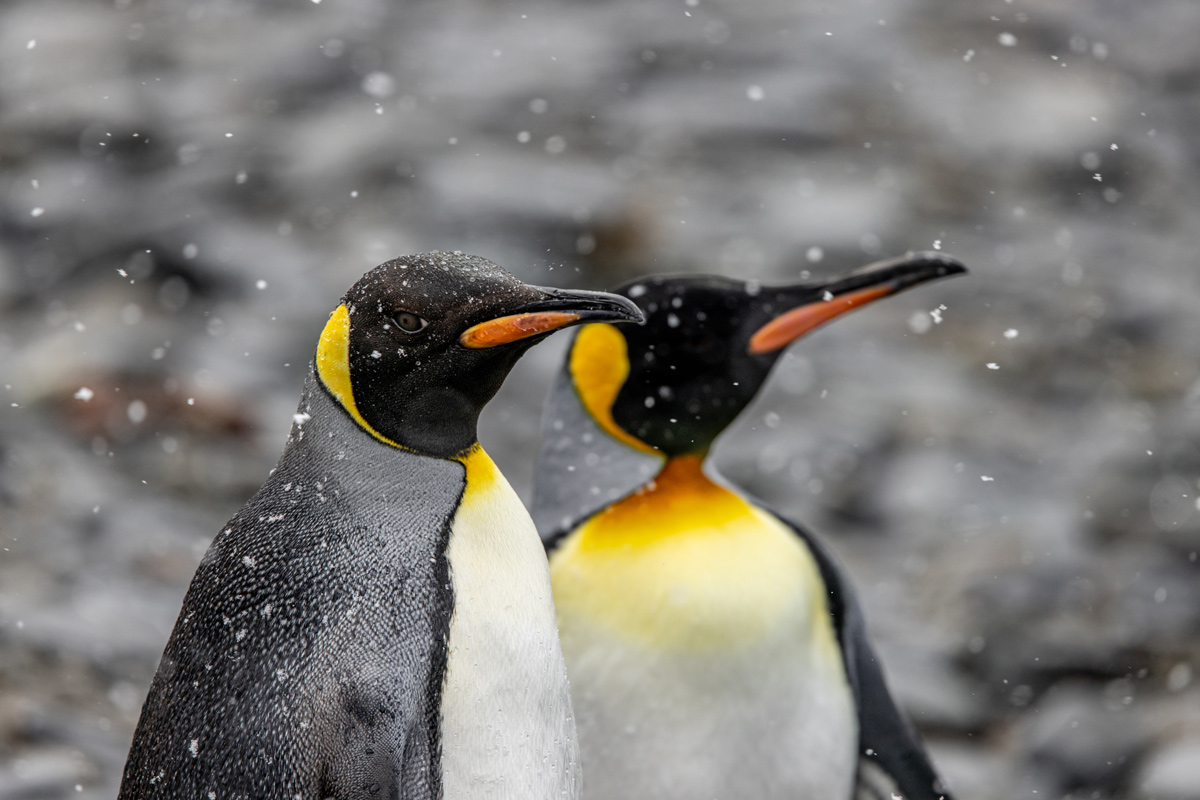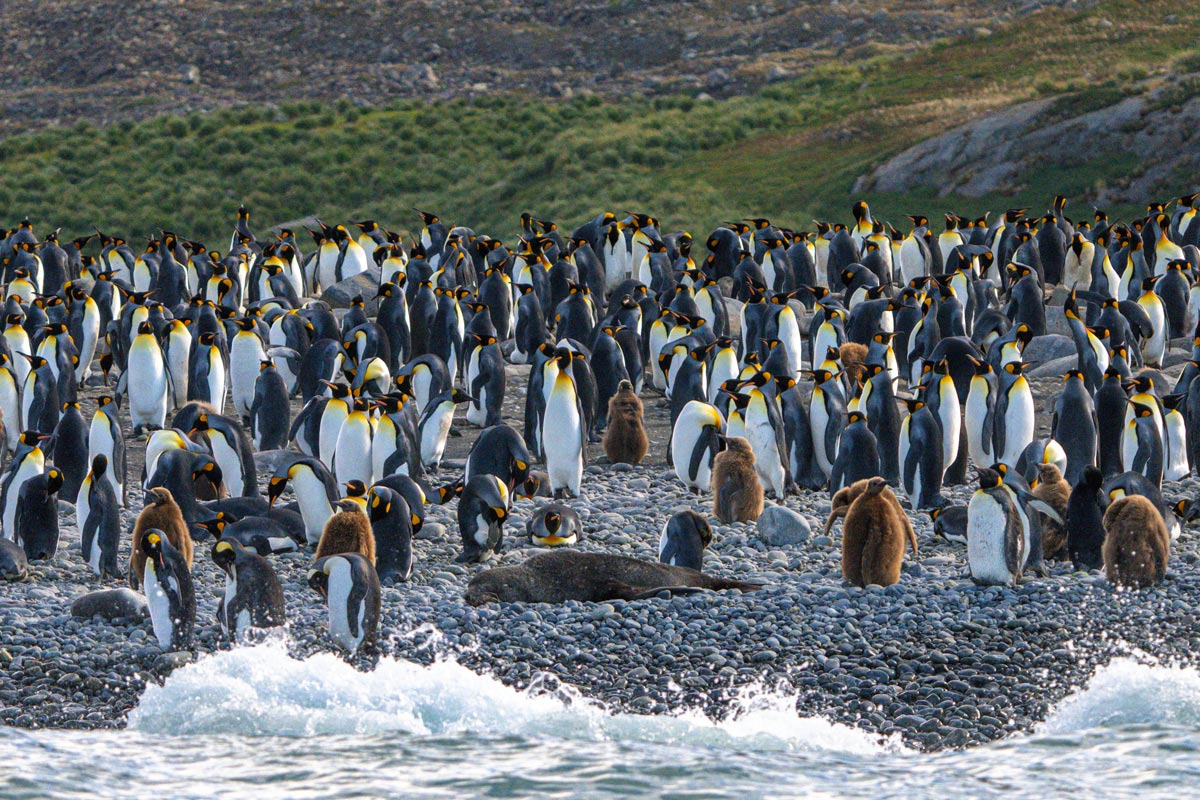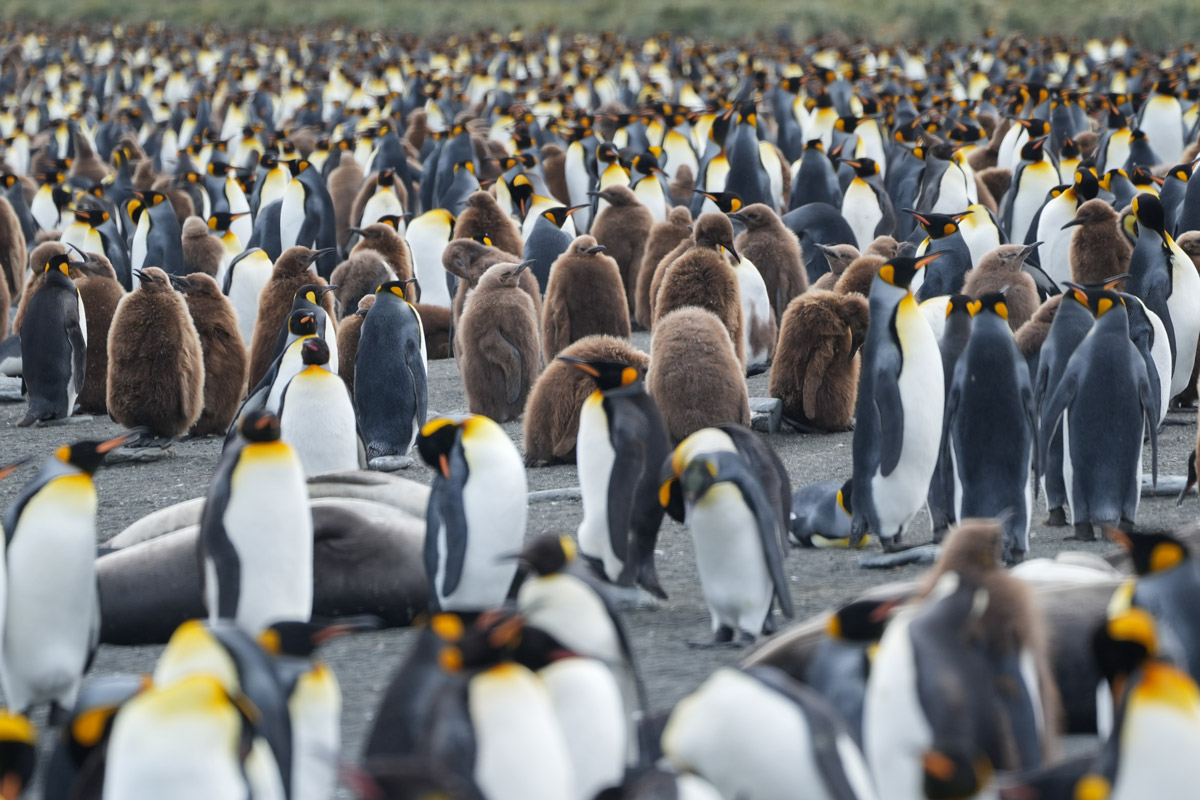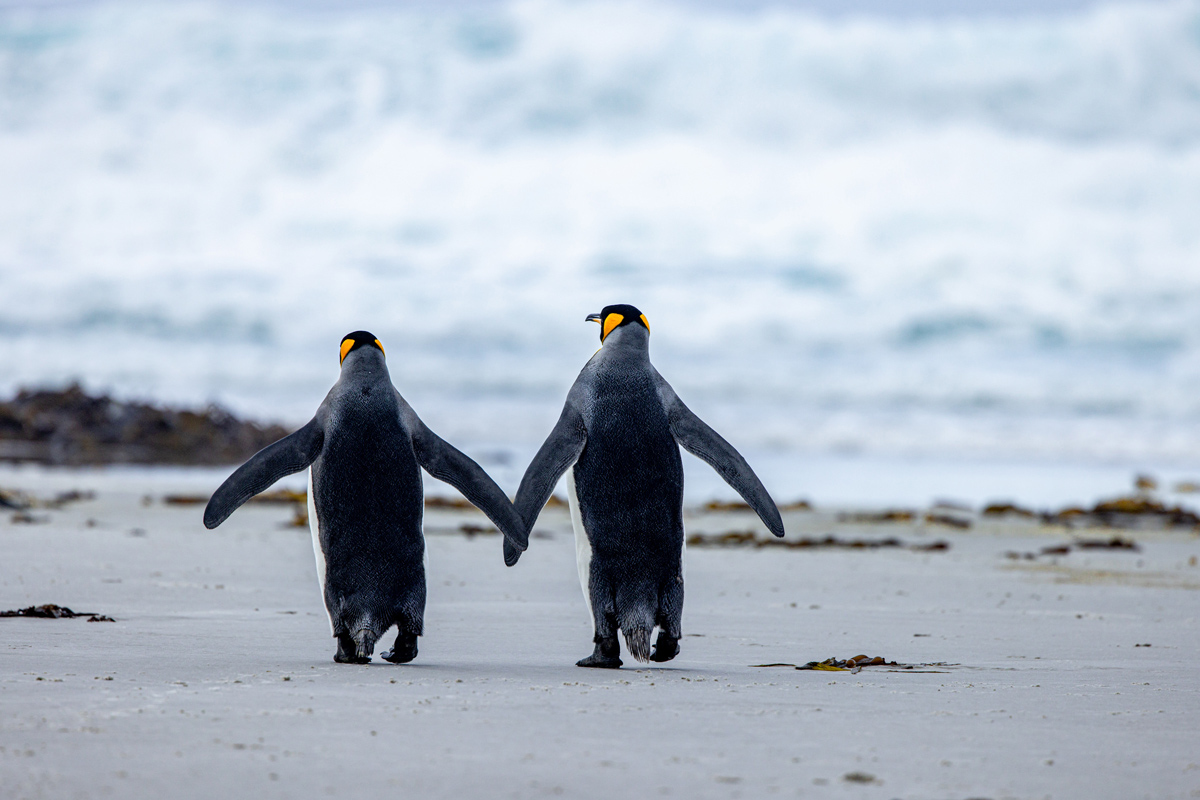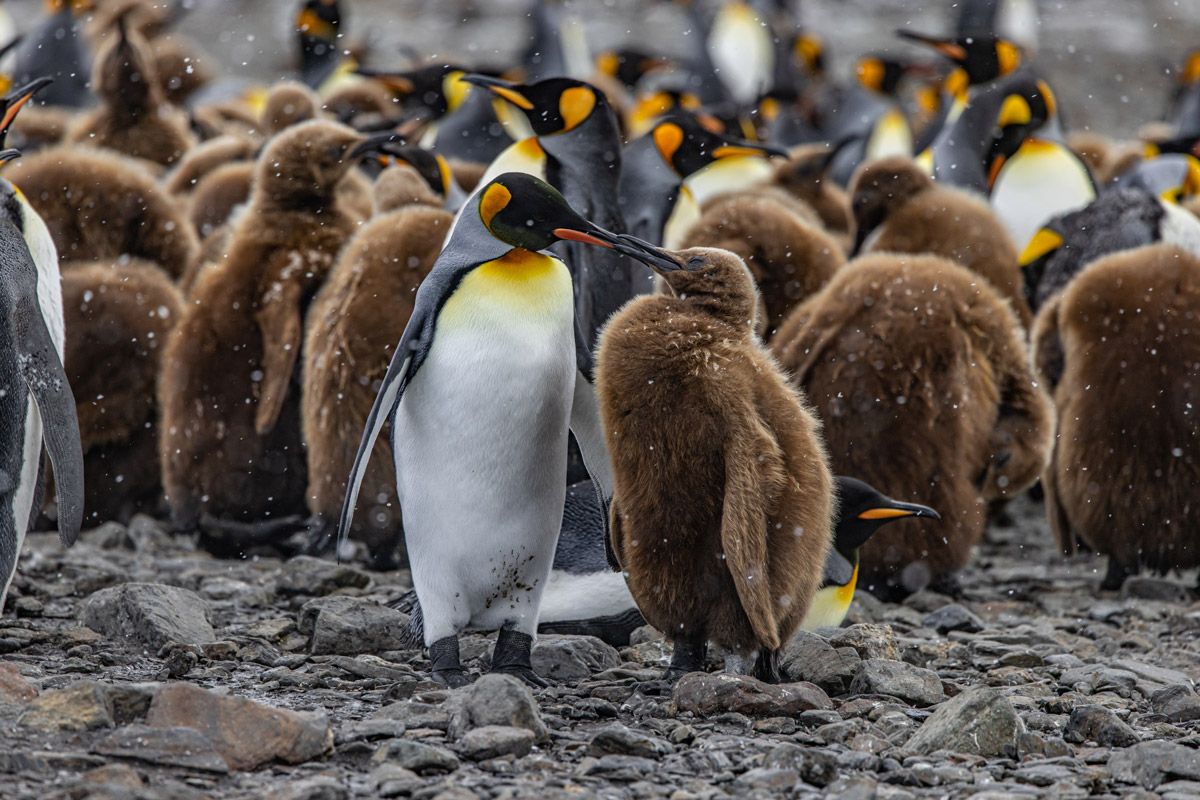King Penguin
When we arrive in South Georgia, the mighty King Penguin is a sight to behold. When you see your first one, two, or three – that’s exciting. When you see thousands of them in one spot, that is exhilarating. They are one of the several different species that we encounter, but these birds are unique in their special way. Let’s learn more about this icon of the sub-Antarctic, a creature you might come across on one of our Antarctica expeditions!
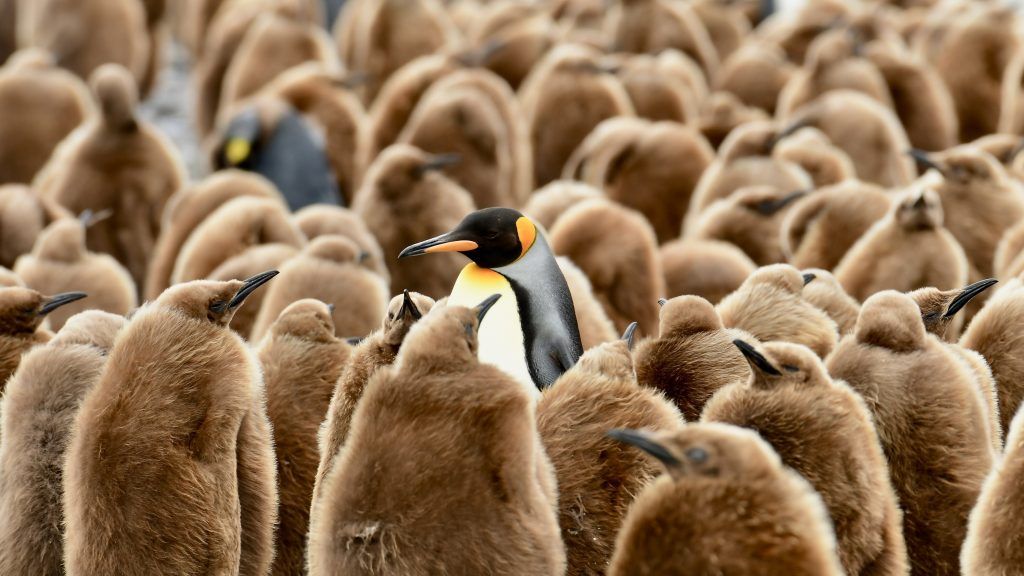
Did you know that those adorable fluffy brown birds are king penguin chicks?
King Penguin Quick Overview
| Scientific Name | Aptenodytes patagonicus |
| Population | Estimated at approximately 2.25 million individuals and increasing |
| Regions | Sub-Antarctic islands and southern oceanic regions |
| Destinations | Falkland Islands, South Shetland Islands, South Georgia, Argentina |
| Average Length | ~1 m (3.3 ft) |
| Average Weight | ~9–18 kg (20–40 lbs) |
| Diet Habits | Small fish, squid and crustaceans |
Questions Guests Ask About King Penguins
What Do They Look Like?
As you can see in the image above, this sub-Antarctic seabird has a black-and-white body and bright orange-yellow colouring on its neck, beak, and chest. Furthermore, one of the most unique king penguin characteristics is that their chicks are usually brown, fuzzy and similar in size, with the possibility of appearing larger at times due to their feathers. This made early explorers think that they were actually a different species.
How Did It Get Its Name?
It was entitled this way because when it was first discovered, it was thought that this species was the largest in the wild and referring to it as “king” as a sign of loyalty. An adult is usually 90 to 100 cm tall (35-39 inches) and weighs between 9 and 18 kg (20–40 lbs), with males being slightly heavier than females. This is a considerable size. However, in the 1800s, a larger species, the emperor penguin, was discovered. Growing up to 1.25 m (4.1 ft), this seabird is now considered the largest penguin species. Despite having a new king in the area, the names were not changed.
Why Are Their Chicks So Big and Brown?
Their chick looks so different that they are often mistaken for a different species. However, the explanation for this distinctive difference is that their large size helps them store fat during the cold Antarctic months when food is scarce. Additionally, their brown plumage color, which is very visible and different from when they are mature, is used for insulation during their development.
What Do They Eat?
The king penguin’s diet mainly consists of small fish, unlike other species that mostly feed on krill. They are also known to eat squid. These creatures spend a lot of time in the ocean feeding, and they can dive down to great depths in search of food. They can also remain underwater for up to 10 minutes.
Where Do They Live?
They are mainly spotted in the northern sub-Antarctic islands, with the largest population on Crozet Island (nearly half a million pairs), as well as on the Prince Edward Islands, Kerguelen Islands, and South Georgia Island. They are also seen as far north as the southern tip of South America, the Falkland Islands, and New Zealand.
Best Expeditions to Spot King Penguins
How Is Their Breeding?
Breeding is preceded by a moult, during which they shed their old feathers, which are replaced by new ones. Unlike other species, they do not build a nest and instead carry their eggs on their feet, covered by a flap of skin called a brood patch.
Are They Monogamous?
These sub-Antarctic giants are monogamous and mate with only one partner each season when they return from their hunting grounds to moult their feathers. Males utilise a combination of vocalisations and visual displays to court a female. The pairs cooperate to hatch their eggs and take turns keeping the chick warm and fed. While one sits with the chick, the other goes off to hunt. They switch roles approximately every week.
Is This the Same Penguin in the Movie “Happy Feet”?
No! Seeing these photos, you might think that Mumble and his friends are this bird species, but in fact, the real species is their close cousin, the Emperor penguins! As mentioned earlier, these two species resemble each other a lot, as they are from the same family (“Spheniscidae”) and genus (“Aptenodytes”), but they still have many differences between them.
What Are the Differences Between the Emperor and King Penguins?
The emperor species is larger but has shorter bills and flippers. They also have yellow-orange patches on their necks with a black collar, whereas the king penguin has brighter orange and yellow ear patches along with a more orange chest. Lastly, while emperors breed on the Antarctic ice, kings are found on the sub-Antarctic islands.
What Is Their Life Expectancy?
Their lifespan is usually around 15-20 years and varies depending on many factors, such as predators, human impact (hunting, overfishing) and climate change. Also, this species holds the record for the oldest penguin ever documented. It was a female called Oma, and she lived for 46 years in Wuppertal Zoo in Germany.

Did you know that a colony of penguins can also be called a rookery, a waddle, or a raft?
How Many of These 10 King Penguin Facts Did You Already Know?
- Their biggest threats in the wild are leopard seals, killer whales, skuas, and giant petrels.
- This sub-Antarctic giant lays a single egg every 1.5 to 2 years.
- Males and females take turns incubating.
- They nest in large colonies across the sub-Antarctic islands.
- Its beak, neck, and upper chest display vivid orange colouring.
- This seabird is smaller than the Emperor penguin, making it the second largest.
- The chick is looked after until it reaches 14-16 months of age before it ventures into the sea independently.
- They reach sexual maturity at about 4 to 5 years.
- Because of the lengthy nurturing period, there is always a parent in the colony.
- Their population is very strong and not at risk for extinction, and it is considered as ‘Least Concern’ in the Red List assessment by the IUCN.
Contact Us
If you’re interested in having a memorable encounter with these fantastic animals, Reach out to our team to learn more about our voyages any time!


